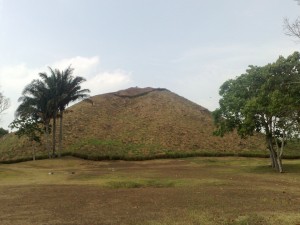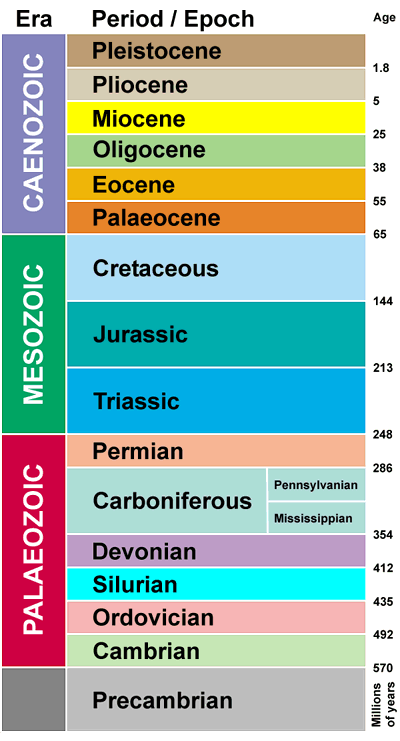Civilisations:
10 Ancient Civilizations That History Forgot
Hattian Civilisation
Zapotec Civilisation
Vinca Civilisation
Hurrian Civilisation
Nok Civilisation
Punt Civilisation
Norte Civilisation
Elamite Civilisation
Dilmun Civilisation
Harappan Civilisation
Notes on the Maya Civilisation:
Located in Mexico and Guatemala and extending into the Yucatán peninsula.
Evolved hieroglyphic writing, astronomy, mathematics and calendrical systems.
Notable cities are – Palenque, Tikal, Tulum, Chichén Itzá, Copán and Uxmal.
Originating in the Yucatán around 2600 B.C.
Classic period, A.D. 200-900.
Built on earlier civilizations such as the Olmec, the Maya developed astronomy, calendrical systems and hieroglyphic writing.
Built temple-pyramids, palaces and observatories, all built without metal tools or wheel (apparently.)
Skilled farmers, clearing large sections of tropical rain forest
Built sizeable underground reservoirs for rainwater.
Skilled weavers and potters
Created trade network with distant people through jungles and swamps
Traditional belief in Kulkulkan – visitor and knowledge creator
Ceremonial plazas and temples with the Sun and stars
Chichén Itzá, the principal Maya city of the Yucatán Peninsula, at the vernal and autumnal equinoxes, the Sun gradually illuminates the pyramid stairs creating the image of a snake slithering down the sacred mountain to Earth.
Palenque – Pacal’s tomb in the Temple of the Inscriptions at winter solstice, the Sun sets behind the high ridge beyond the temple, in line with the centre of the temple roof. As the Sun crosses the sky, it enters a doorway in the temple, hits the back wall and, as it heads for the horizon beyond the temple, appears to descend the temple stairway into Pacal’s tomb. Pacal’s death and entry into the Underworld are thus equated with the Sun’s death and entry into the Underworld.
Architecture such as the Caracol at Chichén Itzá was also aligned with the appearance of celestial bodies such as the Pleiades and Venus.
Temple at Uxmal contains hundreds of Venus symbols.
The Dresden Codex, one of four surviving Maya chronicles, contains an extensive tabulation of the appearances of Venus, and was used to predict the future.
They used 20-day months, and had two calendar years: the 260-day Sacred Round, or tzolkin, and the 365-day Vague Year, or haab.
These two calendars coincided every 52 years. The 52-year period of time was called a “bundle”
The Sacred Round of 260 days is composed of two smaller cycles: the numbers 1 through 13, coupled with 20 different day names. of gods – Imix, Ik, Akbal, Kan, Chicchan, Cimi, Manik, Lamat, Muluc, Oc, Chuen, Eb, Ben, Ix, Men, Cib, Caban, Eiznab, Cauac, and Ahau.
The Maya wrote using 800 individual signs or glyphs, paired in columns that read together from left to right and top to bottom.
The Maya used the vigesimal system for their calculations – a system based on 20 rather than 10. This means that instead of the 1, 10, 100, 1,000 and 10,000 of our mathematical system, the Maya used 1, 20, 400, 8,000 and 160,000.
Maya Numerals:
| Olmec | 1200-1000 B.C. |
| Early Preclassic Maya | 1800-900 B.C. |
| Middle Preclassic Maya | 900-300 B.C. |
| Late Preclassic Maya | 300 B.C. – A.D. 250 |
| Early Classic Maya | A.D. 250-600 |
| Late Classic Maya | A.D. 600-900 |
| Post Classic Maya | A.D. 900-1500 |
| Colonial period | A.D. 1500-1800 |
| Independent Mexico | A.D. 1821 to the present |
Notes on the Olmec Civilisation:
Olmec is the Aztec name for this civilisation, beginning and which prospered in Pre-Classical (Formative) Mesoamerica from c. 1200 BCE to c. 400 BCE and is generally considered the forerunner of all subsequent Mesoamerican cultures such as the Maya and Aztecs.
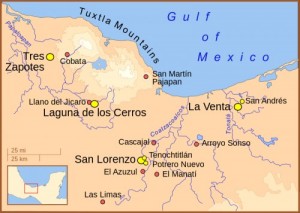 Centred in the Gulf of Mexico (now the states of Veracruz and Tabasco) their influence and trade activity reached as far south as present-day Nicaragua.
Centred in the Gulf of Mexico (now the states of Veracruz and Tabasco) their influence and trade activity reached as far south as present-day Nicaragua.
Monumental sacred complexes, massive stone sculpture, ball games, chocolate drinking and animal gods were features of Olmec culture.
The Olmec religious practices of sacrifice, cave rituals, pilgrimages, offerings, ball-courts, pyramids and a seeming awe of mirrors, was on to all subsequent civilizations in Mesoamerica.
By c. 1200 BCE significant urban centres developed at San Lorenzo (the earliest), La Venta, Laguna de los Cerros, Tres Zapotes and Las Limas. Typical Olmec trade goods included obsidian, jade, serpentine, mica, rubber, pottery, feathers and polished mirrors of ilmenite and magnetite. The first pyramid was constructed at Venta.
It is known, apparently, that they worshipped a sky-dragon and they believed four dwarves held up the sky.
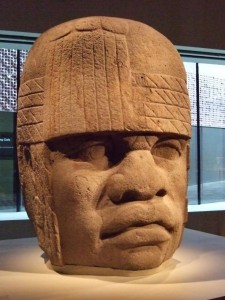 17 colossal heads have been found, 10 from Sam Lorenzo. These were carved in basalt, weighing 8 tons and are 3m high. In some cases they have been transported 80 km or more, presumably using huge balsa river rafts.
17 colossal heads have been found, 10 from Sam Lorenzo. These were carved in basalt, weighing 8 tons and are 3m high. In some cases they have been transported 80 km or more, presumably using huge balsa river rafts.
The ruler often wears a protective helmet and is sometimes shown with jaguar paws hanging over the forehead, perhaps representing a jaguar pelt worn as a symbol of political and religious power.
Jade and ceramic were popular materials used for sculpture. 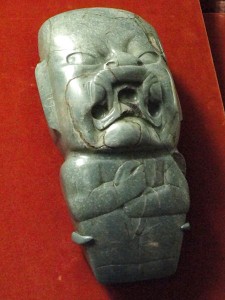 A notable jade carving is the Kunz ceremonial axe-head in the American Museum of Natural History in New York. The jade has been worked to represent a were-jaguar creature using only jade tools and then polished, perhaps using a jade abrasive. Animals were a popular subject, especially those most powerful ones such as jaguars and eagles and such sculptures were often buried.
A notable jade carving is the Kunz ceremonial axe-head in the American Museum of Natural History in New York. The jade has been worked to represent a were-jaguar creature using only jade tools and then polished, perhaps using a jade abrasive. Animals were a popular subject, especially those most powerful ones such as jaguars and eagles and such sculptures were often buried.
The sky-dragon and the feathered-snake god, would reappear in similar form in later religions. The snake-god would be transformed into the major gods Kukulcan for the Maya and Quetzalcoatl for the Aztecs.
The above information has been extracted from a piece written by Mark Cartwright, published in the Ancient History Encyclopedia site on 30 August 2013 under the following license: Creative Commons: Attribution-NonCommercial-ShareAlike
Kunz axe image By Daderot (Daderot) [CC0 or CC0], via Wikimedia Commons
Summary notes on the traditional stories of visitors to ancient civilisations and their Influence:
Oannes to the Babylonians of southern Iraq – writing, agriculture, mathematics and laws.
‘Gods’ to the Egyptians – art and science
Quetzalcoatl to the Mexicans – Fire, house building, peace.
KukKulKan to the Maya of Guatamala – cities, laws and calendar
Virachocato Inca people of Peru – civilising
Timelines:
Timeline of the Stone, Bronze and Iron ages
How to Remember Historical Events by Paul V. Hartman (naciente.com)
Ancient (Unrecorded) History by Paul V. Hartman (naciente.com)
Geological Periods
Ancient Historical Periods
Maya Civilisation Timeline
Timeline of the Stone, Bronze, and Iron Ages
| Lower Paleolithic ca. 2,500,000- 200,000 BC |
Middle Paleolithic ca. 200,000- 50,000 BC |
Upper Paleolithic ca. 50,000- 10,000 BC |
Mesolithic/Neolithic ca. 10,000- 3000 BC |
Bronze Age ca. 3000- 1000 BC |
Iron Age ca. 1000 BC- present |
How To Remember Historical Events
~~ Paul V. Hartman ~~
One of the valuable tools I use to remember historical events in their proper sequence is to commit to memory a reasonably brief outline of significant events at convenient breakpoints in the span of time of human existence. For instance, the first walled settlement of an agricultural society in history I place at 7000 BC at Jericho. The bow and arrow came into use at 15,000 BC, which is also a suspected date for the arrival of man into South America. The land bridge from England to France submerged to form the English channel at 5000 BC, and the Minoan civilization appears in Crete at 2500 BC. These dates are not dead accurate, but they are reasonably close, and by creating a ladder of several of them, one can then place other events within rememberable time periods, and this aids memory.
Here then is the “ladder” I use for events Before Christ:
100,000 BC Beginning of most recent Ice Age.
40,000 Cro-Magnon man appears in Europe.
30,000 Neanderthal dies out. Humans reach North America.
20,000 Maximun ice age extent. Cave paintings appear: France, Spain.
15,000 Bow and arrow appears. Man in South America.
10,000 Ice age begins withdraw; temperatures warm.
8,000 Agriculture appears in Middle East.
7,000 Walled settlement at Jericho. Pottery. Copper.
5,000 Land bridge to England submerges: channel complete.
3,500 Rice farming in China. Mayan civilization begins.
3,000 Evidence for Wheel and Bricks in Egypt and Assyria.
2,500 Pyramids in Egypt; Minoan civilization begins.
2,000 Bronze Age begins in Europe; Stonehenge.
1,700 Hammurabi (Babylon); Code of Law.
1,250 Moses leads the Exodus; Greeks attack Troy. Phoenicia.
1,000 Saul dies, David unites Judah and Israel.
800 Phoenicians establish Carthage; Homer writes Odyssey.
750 Romulus and Remus found Rome. (If you believe it.)
600 Hanging Gardens of Babylon.
550 Cyrus the Great establishes the Persian Empire.
500 Roman Republic begins; so does Athenian Democracy.
460 Pericles. First Peloponnesian War.
400 Death of Socrates. Romans defeat the Etruscans.
335 Alexander begins conquest of the known world.
300 Ptolemy, first Greek Pharoah of Egypt.
265 Punic Wars (Rome vs. Carthage) begin.
220 C'Hin Dynasty will give China its name.
60 First Roman triumvirate: Julius Caesar, Pompey, Crassus
54 Romans invade Britain; Cleopatra Queen of Egypt.
44 Ides of March.
30 Octavian defeats Antony, becomes "Caesar Augustus".
5 Probable year of birth of Jesus of Nazareth.
So. Which event appears in history first, the reign of Solomon or
the story of the wooden horse at Troy? Answer: Solomon is not on
your list, but you know he follows David, who is King in 1000 and
Homer isn't born yet, but Homer will write about events occurring
in 1200, so the wooden horse story is older than Solomon but the
Odyssey isn't. Look how smart you are!
There are some nice books available on the "TimeLine of History" if
you wish to continue this list beyond this period.
Ancient (un-recorded) History
Really Ancient (Unrecorded) History
~~ Paul V. Hartman ~~
Archeological Evidence Supports the Following:
2.5 Million BC Hominids as “australipithecus”. (Ape-men)
(may exist as a few varieties)
1.6 Homo Habilis, the “Tool maker” (the tools are stones)
1.0 Homo Erectus. (“Upright walker”)
Migration across a green Sahara about 900,000 BC
200,000 Homo Sapiens Sapiens in East Africa Rift Valley.
110,000 Last “Ice Age” begins.
90,000 2nd Migration (Sahara is green again) -> Near East
40,000 First racial split: Europe/Asia with South Pacific
(skin is still dark in all groups)
35,000 Second racial split: Europe (Caucasian) with Asian
(Oriental). Skin in both groups will lighten as
they migrate north to colder climates.
30,000 Arrival of Homo Sapiens in Australia (dark skin)
28,000 Migration to Americas: last race to appear: Red
(“red” breaks off from Oriental)
The first migration, Homo Erectus, will migrate to most of the world,
except for the Western hemisphere and South Pacific.
From Erectus, Homo Neanderthal will appear about 135,000 and will be
existing when Homo Sapiens of the 2nd migration (beginning in 90,000)
arrives, but lose out and disappear in 35,000. Neanderthals are cold
adapted, short legged, brawny (Stupid looking, but not stupid). Vocal
apparatus believed to be poorly developed but with some communicative
skill.
As the early humans migrate northward (as glaciers retreat) the cold
requires covering (animal skins) which diminishes sun exposure, which
will give a survival advantage to lighter skin for the absorption of
necessary Vitamin D.
Sapiens, being taller, thinner, and (in the beginning) not cold
adapted, will prevail probably because improved communication will
result in a more successful cooperative hunt. An improved stone blade
technology will also help. The slowness to cold adapt will delay the
Sapiens dominance over Neanderthal.
Could Neanderthal breed with Sapiens? Possible but unknown. Both
Neanderthal and Sapiens descend from the Erectus stock, some of which
cross the Sahara (in the first migration) and some of which stay behind.
By the time what stays behind crosses – now as Sapiens – Neanderthal may
have diverged sufficiently to be a separate species. If so, then
Neanderthal could “mate” with Sapiens but not produce fertile offspring.
The migrations across the Sahara (going down the Nile would have been
a more difficult route) in 900,000 and 90,000 coincide with climactic
changes in which the Sahara is green. Early man, following game, “eats”
his way across in each case. In fact, it is a desire to follow the herd
that results in a trans-Saharan migration, not a desire to “explore a new
world”.
The last ice age terminated in 9,600 BC, and about 28,000 BC seems the
appropriate time at which the northeast Asians ate their way across the
Bering land bridge to become America’s Indians and Eskimos. Some
evidence suggests an even earlier migration across the Bering bridge,
which is now submerged beneath the Bering Strait.
Geological Periods
Ancient Historical Periods (Wikipedia and links)
-
- Mesopotamia (3500 BC – 559 BC)
- Indus Valley Civilization (3300 BC – 1300 BC)
- Old Kingdom (Egypt, 3000 BC – 2000 BC)
- Middle Kingdom (Egypt, 2000 BC – 1300 BC)
- Shang Dynasty (China 1600 BC – 1046 BC)
- Vedic period (India 1500 BC – 500 BC)
- New Kingdom (Egypt, 1550 BC – 1070 BC)
- Zhou Dynasty (China 1200 BC – 500 BC)
- Ancient Greece (Greece and Near East, c. 3300 BC- 31 BC
- Jomon period (Japan 800 BC-400 BC)
- Ancient Rome (509 BC-AD 476)
- Yayoi period (Japan 400 BC — AD 300)
- Kofun periodtarget=”new” (Japan 300 – 600)
- Migration period (Europe 200 – 700)
- Coptic period (Egypt 300 – 900)
Maya Civilisation Timeline
| Olmec | 1200-1000 B.C. |
| Early Preclassic Maya | 1800-900 B.C. |
| Middle Preclassic Maya | 900-300 B.C. |
| Late Preclassic Maya | 300 B.C. – A.D. 250 |
| Early Classic Maya | A.D. 250-600 |
| Late Classic Maya | A.D. 600-900 |
| Post Classic Maya | A.D. 900-1500 |
| Colonial period | A.D. 1500-1800 |
| Independent Mexico | A.D. 1821 to the present |

